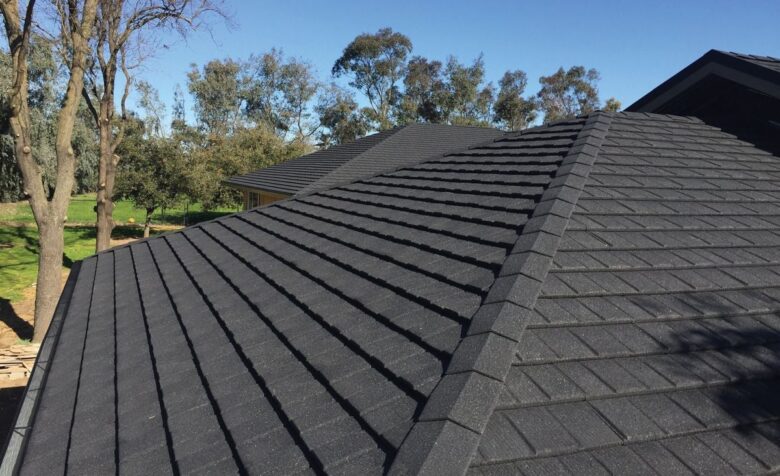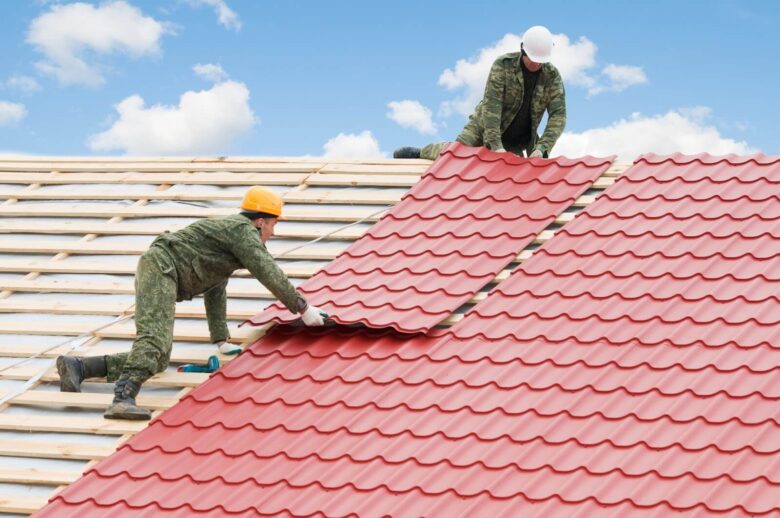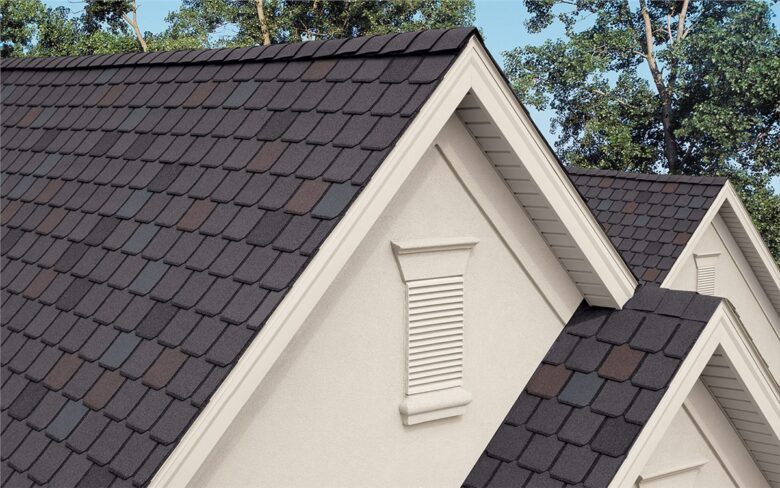Stone-coated metal roof tiles are a roofing option that combines the durability and strength of metal with the aesthetic appeal and functionality of stone coatings. These tiles consist of a metal base, usually made of galvanized steel or aluminum, covered with a layer of specially-formulated acrylic resin, followed by a layer of natural stone chips or ceramic granules.
The result is a highly-resistant and long-lasting roofing material that can withstand harsh weather conditions, resist fire and wind damage, and provide energy savings through its reflective surface. Stone-coated metal roof tiles have gained popularity in recent years due to their versatility, durability, and aesthetic appeal, making them a viable option for both residential and commercial roofing projects.
Contents
Benefits of stone-coated metal roof

Source: mcelroymetal.com
One of the primary benefits of stone-coated metal roof tiles is their exceptional durability and longevity. Unlike other roofing materials that may require frequent repairs or replacements, stone-coated metal roof tiles can last for decades with minimal maintenance. They are resistant to cracking, fading, and chipping, and can withstand extreme weather conditions such as heavy rain, hail, and high winds. This makes them a popular option for homeowners and business owners who want a reliable and long-lasting roofing solution.
In addition to their durability, stone-coated metal roof tiles are also highly energy-efficient. Their reflective surface can help reduce heat absorption and keep the interior of the building cooler, resulting in lower energy costs and a more comfortable living or working environment. This is especially important in hot climates, where traditional roofing materials such as asphalt shingles or clay tiles can trap heat and increase energy consumption. By choosing stone-coated metal roof tiles, property owners can enjoy significant energy savings over time and reduce their environmental footprint.
Comparison with other roofing materials
When compared to other roofing materials, stone-coated metal roof tiles offer several advantages that make them a superior option in many cases.
Stone-coated Metal Roof Tiles vs Roofing Shingles
When it comes to roofing options, both stone-coated metal roof tiles and roofing shingles offer unique benefits and drawbacks. Roofing shingles are a popular choice due to their affordability, versatility, and ease of installation. They are also available in a wide range of colors and styles to match different architectural designs. However, shingles have a relatively short lifespan compared to stone-coated metal roof tiles and may require frequent maintenance and replacement over time.
They are also more prone to damage from high winds, hail, and extreme temperatures. In contrast, stone-coated metal roof tiles are more durable and resistant to weathering, making them an ideal option for areas with harsh climates. They are also more energy-efficient, helping to reduce heating and cooling costs over time. While stone-coated metal roof tiles may be more expensive upfront, their longevity and durability can ultimately provide cost savings and peace of mind for homeowners. Additionally, stone-coated metal roof tiles offer a unique aesthetic that can add value and curb appeal to any property.
Stone-coated Metal Roof Tiles vs Metal Roofing

Source: legacyusa.com
Both stone-coated metal roof tiles and metal roofing offer unique advantages for homeowners. Metal roofing is known for its durability, longevity, and low maintenance requirements. It can withstand harsh weather conditions, such as heavy rain, high winds, and hail, and is fire-resistant. Metal roofing is also energy-efficient and can help reduce cooling costs in hot climates. However, metal roofing may not be as aesthetically pleasing as stone-coated metal roof tiles, which are designed to mimic the look of other roofing materials, such as tile, slate, or wood.
In contrast, stone-coated metal roof tiles offer homeowners the best of both worlds: the durability and energy efficiency of metal roofing with the aesthetic appeal of traditional roofing materials. They are resistant to weathering, provide good insulation, and can help reduce heating and cooling costs. Stone-coated metal roof tiles are also lightweight, making them easier to install and less likely to put stress on a home’s structure. While stone-coated metal roof tiles are generally more expensive than metal roofing, their durability and longevity can provide long-term cost savings for homeowners.
Stone-coated Metal Roof Tiles vs Clay Tiles
Both stone-coated metal roof tiles and clay tiles are popular roofing materials due to their aesthetic appeal and durability. Clay tiles have been used for centuries and offer a classic look that many homeowners find attractive. They are also highly durable and can last up to 50 years or more with proper maintenance.
However, clay tiles can be heavy and require a strong roof structure to support their weight. They can also be prone to cracking and breaking in extreme weather conditions, such as hail or high winds. In contrast, stone-coated metal roof tiles are designed to mimic the look of clay tiles while offering greater durability and weather resistance. They are lightweight, making them easier to install and less likely to put stress on a home’s structure.
They are also more resistant to damage from hail and wind than clay tiles. Additionally, stone-coated metal roof tiles are energy-efficient and can help reduce heating and cooling costs. While stone-coated metal roof tiles are generally more expensive than clay tiles, their longevity and durability can provide long-term cost savings for homeowners, making them a popular alternative for those who desire the look of clay tiles without the maintenance concerns.
Manufacturing process
The manufacturing process typically involves the following steps:
- Cutting the base metal: The first step in making stone-coated metal roof tiles is to cut the base metal into the desired shape and size. This metal is typically galvanized steel or aluminum, which is chosen for its strength, durability, and resistance to rust and corrosion.
- Applying an acrylic primer: Once the metal has been cut, it is coated with an acrylic primer to help it adhere to the other materials in the process. This primer also helps to protect the metal from corrosion and other forms of damage.
- Applying stone chips: After the primer has dried, the metal is coated with a layer of small stone chips that have been coated with an acrylic binder. These stone chips are typically made of natural materials like granite or basalt and are chosen for their durability and resistance to weathering.
- Applying an adhesive layer: The stone chips are then covered with a layer of acrylic adhesive, which helps to hold them in place and create a strong, weather-resistant surface.
- Adding additional coatings: Depending on the manufacturer’s process, additional layers of acrylic or other coatings may be applied to the metal and stone surface to enhance the weather resistance and durability of the finished product.
The materials used in the manufacturing process of stone-coated metal roof tiles are chosen for their durability, resistance to weathering, and ability to bond to each other. Galvanized steel or aluminum provides a strong base for the stone and acrylic layers, while the stone chips offer a protective layer that is both durable and aesthetically pleasing. Acrylic binders and adhesives are used to bond the various layers together and create a cohesive, weather-resistant surface.
Types of Coating

Source: infinityroofer.com
Stone-coated metal roof tiles are available in several types of stone coatings, each with their own unique benefits. The three most common types of stone coatings are ceramic granules, natural stone, and acrylic resin.
- Ceramic Granules: Ceramic granules are a popular choice for stone coatings as they are both durable and come in a wide range of colors. The ceramic granules are baked onto the surface of the metal tiles during the manufacturing process, which helps to ensure that they are firmly attached and won’t wear off over time. Ceramic coatings provide excellent UV resistance, which helps to prevent fading and discoloration over time.
- Natural Stone: Natural stone coatings are made of actual stone chips, such as granite or basalt, that are applied to the surface of the metal tiles. These coatings provide a natural look that many homeowners find attractive, and the stones themselves offer excellent durability and weather resistance. However, natural stone coatings are typically more expensive than other types of coatings and can be more difficult to install.
- Acrylic Resin: Acrylic resin coatings are made of a mixture of acrylic polymers and small stone chips that are applied to the surface of the metal tiles. These coatings offer excellent durability and weather resistance, as well as a wide range of colors and textures. Acrylic resin coatings are also typically less expensive than other types of coatings, making them a popular choice for homeowners on a budget.
Conclusion
In conclusion, stone-coated metal roof tiles offer a number of benefits that make them a popular choice for homeowners looking for a long-lasting and attractive roofing material. Their durability, weather resistance, energy efficiency, and aesthetic appeal make them a great option for homes in a variety of climates and architectural styles. Additionally, the different types of stone coatings available, such as ceramic granules, natural stone, and acrylic resin, offer unique benefits that can help homeowners achieve the look and performance they desire. Whether you are building a new home or looking to replace your existing roof, stone-coated metal roof tiles are definitely worth considering as a top-tier roofing solution.
